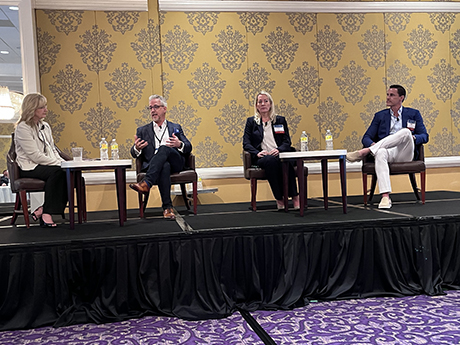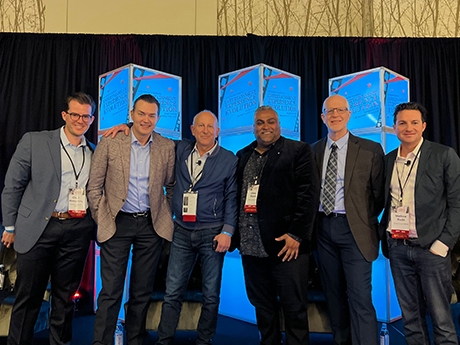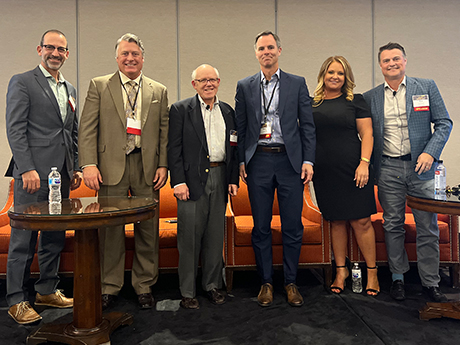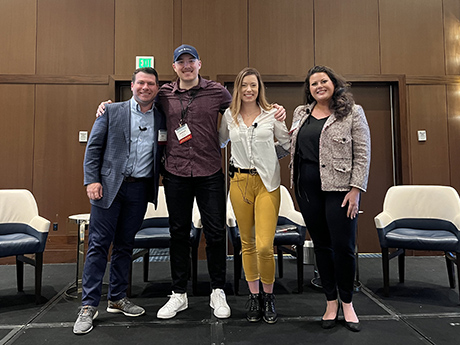CHARLOTTE, N.C. — Multifamily developers are pushing their chips in and aggressively looking for new development deals, especially for sites in and around high-growth markets in the Southeast. Michael Tubridy, senior managing director of Crescent Communities, said his firm isn’t leaving anything to chance and is looking to move quickly on development opportunities. “We’re trying to get as many units on the ground today as possible, because tomorrow will be more expensive,” said Tubridy. “I like the chances of today’s cost environment a lot better than I like the unknown of where we’ll be a year from now or two years from now. Putting a premium on speed to market is something that we are much more focused on; it’s almost the only priority right now.” Tubridy’s comments came during the development panel at InterFace Carolinas Multifamily 2022. The half-day event was held on April 14 at the Hilton Uptown Charlotte hotel and attracted more than 260 attendees from all facets of the multifamily industry in North Carolina and South Carolina. Michael Saclarides, director of Cushman & Wakefield’s Multifamily Advisory Group, moderated the discussion. Crescent Communities is far from the only multifamily developer pursuing ground-up construction opportunities in earnest. In …
Conference Coverage
Build-to-RentConference CoverageDevelopmentFeaturesMultifamilyNorth CarolinaSingle-Family RentalSouth CarolinaSoutheastSoutheast Feature Archive
Conference CoverageFeaturesMultifamilyNorth CarolinaSouth CarolinaSoutheastSoutheast Feature Archive
Multifamily Operators Battle Fraud, Labor Shortages on the Front Lines, Say InterFace Panelists
by John Nelson
CHARLOTTE, N.C. — Property managers are navigating a minefield of issues in today’s apartment market. Analyzing renter applications for fraud, collecting overdue rent and turning over units from freeloading tenants are all in a day’s work for savvy apartment operators. Amanda Kitts, senior vice president of property management at Northwood Ravin, a multifamily owner and operator based in North Carolina, said that part of the role of an operations professional today entails poring over documents like check stubs, IDs and employment records to make sure the prospective resident is creditworthy. She said that fraud is more prevalent in some markets than others, so it’s imperative that property managers are adequately trained. “Charlotte still is a very big market for fraud, but Durham not so much. Chapel Hill is squeaky clean; nobody does anything wrong in Chapel Hill,” joked Kitts. “We have these applications and check stubs, and maybe one could be off, and you have to investigate and Google. We’re almost mini-FBI investigators.” Kitts’ comments came during the leasing and operations panel at France Media’s InterFace Carolinas Multifamily, which took place April 14 at the Hilton Uptown Charlotte. The networking and information conference drew more than 260 attendees from all facets …
LOS ANGELES — After a two-year slog through COVID-19, consumer demand for shopping, dining and entertainment experiences has become a cresting tidal wave ready to descend upon the shore. The term “pent-up” is frequently used to describe this mentality, but industry professionals know that cliché doesn’t really do justice to the degree of concentrated demand for just about any form of dining out, barhopping, gaming and fraternizing. To this end, the National Retail Federation (NRF) projects that total retail sales across both digital and brick-and-mortar forums will grow between 6 to 8 percent year over year in 2022. And yet, to invoke another nautical metaphor, this scenario is not necessarily a rising-tide-lifts-all-boats phenomenon — at least not in the long run. The reality for developers and operators of shopping, dining and entertainment properties is that in order to win customer loyalty in the long haul and infuse a center with true cross-shopping potential and destinational status, they have to create a legitimately unique draw. This notion, while not necessarily revelatory and Earth-shattering in the current brick-and-mortar retail market, has only been more deeply ingrained by the events of the last 24 months. At the seventh-annual Entertainment Experience Evolution conference that …
Electric Vehicle Manufacturing Powers Real Estate Activity Along I-85 Industrial Corridor, Say InterFace Panelists
by John Nelson
CHARLOTTE, N.C. — The Southeast has long been home to automotive giants such as Honda, Hyundai, Toyota and Mercedes-Benz, as well as their large network of suppliers. In 2021, BMW led the nation in automotive exports by value, the eighth consecutive year the German automaker held that distinction. BMW produced and exported $10.1 billion worth of cars and SUVs from its mega campus in Spartanburg, S.C., last year, and the company recently announced two new facilities — one on its campus and the other across Interstate 85 — that will total $300 million in investment. Similarly, Hyundai Motor Manufacturing Alabama, the regional headquarters and only U.S. plant for the South Korean auto giant, announced last week that it planned to invest $300 million to expand and improve its Montgomery plant. The initiative will create 200 jobs and accommodate the manufacturing of the hybrid Santa Fe vehicle line and launch of the first Electrified Genesis GV70 SUV. Hyundai Motor Group said it aims to sell 1.87 million battery electric vehicles (BEVs) annually by 2030 in order to secure a 7 percent global market share of BEVs sold. The automaker announced on April 12 that it plans to invest $7.4 billion in …
AlabamaConference CoverageFeaturesGeorgiaIndustrialNorth CarolinaSouth CarolinaSoutheastSoutheast Feature ArchiveVirginia
I-85 Corridor Markets See Explosion of Industrial Development, But InterFace Panelists Wonder if Housing Will Follow
by John Nelson
CHARLOTTE, N.C. — During the closing panel at France Media’s InterFace I-85 Industrial Corridor conference, brokers from the major markets along the 666-mile interstate gave updates about developments and opportunities in their territories. Brockton Hall, vice president of Colliers’ Upstate South Carolina office, said that the Greenville-Spartanburg industrial market in South Carolina had 16 million square feet of industrial space under construction, which represents an inventory growth of approximately 7.4 percent. Graham Stoneburner, senior vice president of Cushman & Wakefield, said that the Richmond, Va., market currently had 11 million square feet underway, which represents an inventory growth of 11 percent. Similarly Robbie Perkins, shareholder and market president at NAI Piedmont Triad, said North Carolina’s Triad region had 8.7 million square feet in the development pipeline, a nearly 11 percent growth rate compared to the market’s 80 million-square-foot inventory. During nearly every panel throughout the conference, which was held on Wednesday, April 13 at the Hilton Uptown Charlotte, brokers, investors and developers described the industrial growth along the I-85 Industrial Corridor as “unprecedented.” “There’s a real lack of supply at the moment, but we have a lot coming,” said John Montgomery, managing director of Colliers’ Upstate South Carolina office, during …
By Taylor Williams With the COVID-19 pandemic largely in society’s rearview mirror and warm weather months approaching, Americans are fired up to recoup lost time at their favorite restaurants, bars and entertainment venues. But the collision of this pent-up demand with 40-year inflationary highs means that many consumers are going to be more selective about where they eat, drink and source entertainment. To that end, meals, drinks, games and activities must offer a truly unique experience to justify consumer spending of their stretched dollars and to capture the Holy Grail of repeat spending/visits. That’s not to say that run-of-the-mill, traditional food and beverage (F&B) and entertainment concepts won’t rebound to some extent. But the concepts that deliver their offerings to customers in ways that are truly unique and memorable will be the ones that recognize the strongest sales growth and build the most enduring brand loyalties. Strategies, philosophies and exemplary practices that go into making this endeavor a reality were at the forefront of a panel discussion at the seventh-annual Entertainment Experience Evolution conference that took place in mid-March in Los Angeles. Hosted by Shopping Center Business, the flagship publication of Atlanta-based France Media Inc., the event drew more than …
LOS ANGELES — After bottoming out at 78.7 percent in the second quarter of 2021, private-pay seniors housing occupancy has been on a slow, steady climb, according to data from the National Investment Center for Seniors Housing and Care (NIC). The most recent data — for the fourth quarter of 2021 — showed occupancy at 81 percent. However, the pace of recovery varies widely among individual markets, individual companies and even individual properties. “Some people are able to manage the turmoil. Some are even thriving, or at least doing pretty well,” said J.P. LoMonaco, president of Valuation & Information Group. “Other people are really floundering. The questions I’m getting all revolve around occupancy, inflation, maintaining margins and revenue growth.” LoMonaco’s comments came as moderator during a panel titled, “The Power Panel: CEOs Discuss the State of the Industry” at France Media’s InterFace Seniors Housing West conference in Los Angeles on Feb. 24. Nearly 225 industry professionals attended the event. Other panelists included Chris Belford, CEO, Sinceri Senior Living; Rob Leinbach, principal, Cadence Living; Bill Pettit, president, R.D. Merrill Co.; Courtney Siegel, president and CEO, Oakmont Management Group; and Dave Sedgwick, president and CEO, CareTrust REIT. All the panelists reported their …
InterFace Panel Names What’s Hot for Social Media Marketing in the Student Housing Sector
by Katie Sloan
DALLAS — It comes as no surprise that digital marketing — and chiefly, marketing via social media — is one of the best ways to reach potential new renters in the student housing space. Students spend a massive amount of their downtime scrolling through various social media platforms, from TikTok to Instagram. And while a focus on digital marketing within the sector has been seen for some time, the COVID-19 pandemic brought an even greater emphasis on the space by eradicating opportunities for traditional marketing methods such as in-person events and tours. In December, a panel of marketing specialists discussed what’s hot and what’s not for social media marketing at InterFace Conference Group’s third annual LeaseCon/TurnCon conference in Dallas. According to a 2021 survey noted by panel moderator Alison Slager, national business development executive for LeaseLabs by RealPage, 79 percent of marketers used paid ads across social media platforms. With marketing budgets tightening, it’s important to know what resonates with today’s students to ensure all marketing dollars are well spent. Instagram Panelists agreed that the most dominant social media marketing platform is currently Instagram, particularly with its recent addition of Reels, a tool which allows users to post short-form videos. “Instagram …
Apartment Leasing, Management and Operations Continue to Adapt to Market Needs, Says InterFace Panel
ATLANTA — For the past few months, the apartment sector has been in an upswing from an owner and operator perspective. Rents are rising and occupancy rates are high. However, some fear that these positives in the real estate market are going to be short-lived and eventually come to an end. Kevin Owens, division president of RPM Living, said that when the hottest geographic markets start to slow down, then other markets are going to follow suit. “Boise, Idaho is the hottest market from a rent growth standpoint in the country for the last few months, and it took a hit in November. So, if the hottest markets are going to start slowing down, then other markets are going to start slowing down. It’s just a natural progression,” said Owens. Owens’ comment came from a panel titled: “A Report from the Frontlines: What is the Outlook for Leasing, Management & Operations in 2022?” The discussion was one of the many that occurred at France Media’s InterFace Multifamily Southeast conference at the Westin Buckhead hotel in Atlanta on Dec. 2. The panel experts included moderator Craig Thompson, partner at Carr, Riggs & Ingram LLC; Kevin Owens, division president of RPM Living; …
ATLANTA — This year marked a golden age in terms of operating or selling multifamily properties, according to Alan Dean, region president of Terwilliger Pappas, a development firm with four offices in the Southeast. But given the rising costs associated with land acquisition, materials and labor, the challenge has been putting together new deals. “Anyone that got deals done shortly after COVID hit, those deals are going to be very valuable because they’re going to be opening up with less competition on lease-up,” said Dean. Dean’s comments came during a panel entitled “What’s the Outlook for Development in 2022?” at the 12th annual InterFace Multifamily Southeast conference. The event, which took place Thursday, Dec. 2 at the Westin Buckhead hotel in Atlanta, drew more than 300 industry professionals. Joining Dean on the panel were Jay Curran, president of Charlotte, N.C.-based Crescent Communities; Woody Rupp, chief investment officer of Atlanta-based Brand Properties; Harvey Wadsworth, managing director of Atlanta-based Portman Residential; and Justin Weintraub, principal and chief development officer of Birmingham, Ala.-based Daniel Corp. Robert Stickel, executive vice chair with Cushman & Wakefield in Atlanta, moderated the panel. High prices for dirt, long entitlement processes and increased competition in the marketplace have …











